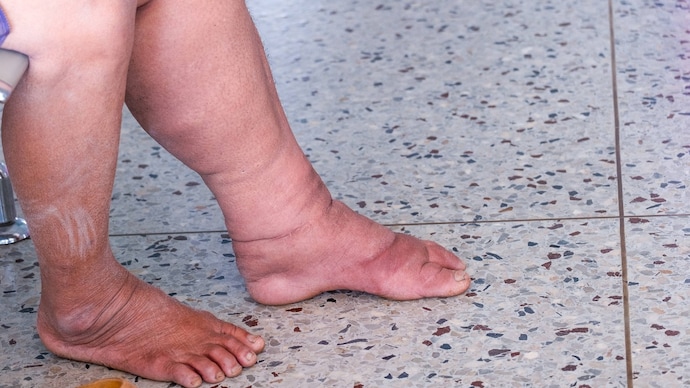How monsoon increases parasite transmission, leading to swollen feet
Monsoon rains lead to a rise in vector-borne diseases, including lymphatic filariasis (LF), a serious condition that causes lifelong disability.

In short
- India will have 345 LF-affected endemic districts by 2023
- Warmer temperatures and unpredictable monsoon patterns increase mosquito breeding and LF transmission
- India’s strategy includes half-yearly MDA campaigns, vector control and community-based prevention to eliminate LF by 2027
Monsoons always see a surge in vector-borne diseases. Apart from climate-sensitive diseases like dengue, malaria and chikungunya, lymphatic filariasis (LF) or elephantiasis is also reported in vulnerable populations.
Lymphatic filariasis, often called elephantiasis or filariasis elephantiasisIt is a neglected tropical disease caused by parasitic worms spread by mosquito bites.
These parasites infect the body’s lymphatic system, causing severe and lifelong disability.
In lymphatic filariasis, swelling in the legs occurs due to a disorder in the lymphatic system caused by parasitic worms. These parasites lodge in the lymphatic vessels and block the normal flow of lymph fluid.
Over time, this blockage causes the accumulation of lymphatic fluid, leading to swelling of the affected tissues, known as lymphedema.
This swelling can be severe and often results in thickening of the skin, leading to the typical symptoms of elephantiasis.

According to the Health Ministry, by 2023, India will have 345 endemic districts in Assam, Bihar, Uttar Pradesh, Jharkhand, Odisha, Chhattisgarh, Karnataka, Kerala, Madhya Pradesh, West Bengal and Gujarat, indicating a substantial burden of LF.
However, the country is committed to eliminating the disease by 2027, three years ahead of the global target. This commitment is supported by a comprehensive strategy that includes vector control measures linked to mass drug administration (MDA) and surveillance and active management.
Dr AP Dash, biologist and vice-chancellor of the Bhubaneswar-based Asian Institute of Public Health (AIPH), said, “Monsoon rains enhance mosquito breeding, especially in urban, suburban and rural areas with poor drainage, where stagnant water becomes common. The unpredictability and intensity of monsoon season due to climate change not only increases the mosquito breeding period but also complicates LF transmission patterns.”
Higher temperatures also accelerate the development of immature mosquito stages, producing more generations of mosquitoes per season and increasing the likelihood of infection.

According to Dr Dash, addressing these challenges requires a multi-pronged approach that integrates vector control with environmental management and public health strategies.
“Effective LF management involves not only aggressive vector control, but also inter-sectoral coordination to harmonise water management, waste disposal, removal of cesspools and cesspits, and community-based prevention strategies,” the expert said.
India has developed a comprehensive strategy to eliminate LF, which includes half-yearly Mass Drug Administration (MDA) campaigns starting on February 10 and August 10, comprehensive vector control, and innovative approaches.
MDA provides free anti-filariasis drugs to the eligible population except young children, pregnant women and critically ill individuals.
Improving MDA coverage, ensuring treatment compliance, and implementing preventive measures are essential to prevent disease transmission and reduce the health and economic burden in affected areas.
The next round of MDA will begin on August 10, 2024, and active participation is crucial to protect communities and move toward a LF-free future.


